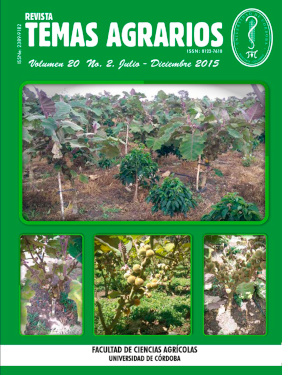Banana flower thrips (Thysanoptera) and their natural enemies in Magdalena, Colombia
Trips (Thysanoptera) del racimo del banano y sus enemigos naturales en el departamento del Magdalena, Colombia
How to Cite
García Sarabia, M., Mizar Caballero, H., & Sepúlveda Cano, P. (2015). Banana flower thrips (Thysanoptera) and their natural enemies in Magdalena, Colombia. Sour Topics, 20(2), 72-80. https://doi.org/10.21897/rta.v20i2.760
Dimensions
license

This work is licensed under a Creative Commons Attribution-NonCommercial 4.0 International License.
Show authors biography
Article visits 1570 | PDF visits
Downloads
Download data is not yet available.
- Abramson, C., Wanderley, P., Mina, A. y Wanderley, M. 2007. Capacity of earwig Marava arachidis (Yersin) to access fennel plants Foeniculum vulgare Mill in laboratory and fild. Ciencia Rural 37:1524-1528.
- Ansaria, M., Shaha, F., Whittakerb, F., Prasadc, M. y Butta, T. 2007. Control of western flwer thrips (Frankliniella occidentalis) pupae with Metarhizium anisopliae in peat and peat alternative growing media. Biological control 40(3):293-297.
- Arias, P., Dankers, C., Liu, P. y Pilkauskas, P. 2004. La economía mundial del banano 1985-2002. Organización de las naciones unidas para la agricultura y la alimentación-FAO, Roma, 96p.
- AUGURA-Asociación de Bananeros de Colombia. 2013. Coyuntura bananera Colombiana 2012. Ed. Comunicaciones AUGURA, 32p.
- Blanco, Y. y Leyva, A. 2007. Las arvenses en el agroecosistema y sus beneficios agroecológicos como hospederas de enemigos naturales. Cultivos Tropicales 28(2):21-28.
- Calixto, C. 2005. Trips del suborden Terebrantia (Insecta: Thysanoptera) en la Sabana de Bogotá. Revista Colombiana de Entomología 31(2):207-213.
- Cañellas, N., Piñol, J. y Espadaler, X. 2005. Las tijeretas (Dermaptera, Forfiulidae) en el control del pulgón en cítricos. Boletín Sanidad Vegetal y Plagas 31:161-169.
- CORPORACIÓN COLOMBIANA DE INVESTIGACIÓN AGROPECUARIA (CORPOICA). 1999. Uso deTrichogramma sp. y Polistes erythrocephalus en el manejo biológico de plagas lepidópteras. Programa Nacional de transferencia de tecnología Agropecuaria, Palmira-Valle (Colombia), 6p.
- DOLE. 2010. Manual de calidad defectos y tolerancias. DOLE, Bogotá, 26p.
- Ekesi, S., Maniania, N., Ampong-Nyarko, K y Onu, I. 1998. Potential of the entomopathogenic fungus, Metarhizium anisopliae (Metsch.) Sorokin for control of the legume flwer thrips, Megalurothrips sjostedti (Trybom) on cowpea in Kenya. Crop protection 17(8):661-668.
- Fernández, F. y Sharkey, M. 2006. Introducción a los Hymenoptera de la Región Neotropical. Sociedad Colombiana de Entomología, Bogotá D. C.894p.
- Gallego, M. y Ambretcht, I. 2005. Depredación por hormigas sobre la broca del café Hypothenemus hampei (Curculionidae: Scolytinae) en cafetales cultivados bajo dos niveles de sombra en Colombia. Manejo Integrado de Plagas y Agroecología 76: 32-40.
- Haddad, O. y Leal, F. 1996. Situación actual y perspectivas de la producción de cambur de exportación y otras Musáceas en el estado Aragua. Papeles de Fundacite Aragua, 41p.
- ICA, 2012. Manejo fiosanitario del cultivo del algodón (Gossypium hirsutum) - Medidas para la temporada invernal. Instituto Colombiano Agropecuario, 43p.
- King, A. y Saunders, J. 1984. Las plagas invertebradas de cultivos anuales alimenticios en America Central. Londresoverseas devel: ADM, 182p.
- Lemos, W., Ramalho, F. y Zanuncio, J. 2003. Age-Dependent Fecundity and LifeFertility Tables for Euborellia Annulipes (Lucas) (Dermaptera: Anisolabididae) A Cotton Boll Weevil Predator in Laboratory Studies with An Artifiial Diet. Environmental Entomology 32(3):592- 601.
- Lewis, T. 1973. Thrips, their biology, ecology and economic important. Academic press of London and New York, 348p.
- Maniania, N., Sithanantham, S., Ekesi, S., Ampong-Nyarko, K., Baumgärtner, J., Löhr, B. y Matoka, C. 2003. A fild trial of the entomogenous fungus Metarhizium anisopliae for control of onion thrips, Thrips tabaci. Crop Protection 22(3): 553- 559.
- Mera, Y., Gallego, M. y Armbrecht, I. 2010. Interacciones entre hormigas e insectos en follaje de cafetales de sol y sombra, Cauca-Colombia. Revista Colombiana de Entomología 36 (1): 116-126.
- Mound, L. y Marullo, R. 1996. The thrips of Central and South America: An introduction (Insecta: Thysanoptera). Memoirs on Entomology International, 487p.
- Mound L. y Kibby, G. 1998. Thysanoptera an Identifiation Guide. Second Edition, CAB International, 67p.
- Nogueira, M. y Gordon, H. 2004. Predaceous Ant Fauna in New Sugarcane Fields in the State of São Paulo, Brazil. Brazilian Archives of Biology and Technology 47(5): 805-811.
- Orduño, N. 2009. Virulencia de Beauveria bassiana y Metarhizium anisopliae sobre el picudo del nopal Metamasius spinolae. México, 2009. 68p. tesis de maestría, Institución de enseñanzas e investigación en ciencias agrícolas.
- Ortiz, M. 1977. El género Frankliniella Karny (Thysanoptera: Thripidae) en el Perú. Revista Peruana de Entomología 20(1): 49-62
- Palacio, M. 2003. Contribuciones al conocimiento de los orígenes y causas de la mancha roja del banano en la zona de Urabá. Tesis de Ingeniería Agronómica, Universidad Nacional de Colombia Sede Medellín, Medellín.
- Pérez, O., González, R., Bisset, J., Navarro, A., Hernández, N. y Martínez, A. 2004. Efectos de Tapinoma melanocephalum (Hymenoptera: Formicidae) sobre huevos de Aedes aegypti (Diptera: Culicidae). Revista Cubana de Medicina Tropical 56(3): 167-171.
- Pirk, G., Di Pasquo, F. y López, J. 2009. Diet of two sympatric Pheidole spp. ants in the central Monte desert: implications for seed–granivore interactions. Insectes Sociaux 56:277–283.
- Porres, V. 2008. Inventario de especies de trips (Insecta: Thysanoptera) del género Frankliniella asociadas a los cultivos de las regiones centro y occidente de Guatemala y su distribución geográfia. Tesis Ingeniero Agrónomo, Universidad Del Valle De Guatemala, Guatemala.
- Posada, O. 1989. Lista de insectos dañinos y otras plagas en Colombia. Bogotá: Instituto Colombiano Agropecuario, 662p.
- SENA- Servicio nacional de aprendizaje. 2002. Caracterización del subsector bananero en Colombia, 136p.
- Soler, J. 2004. Invasiones de hormigas. Animalia XVII(167): 64-66.
- Soto, G. y Retana-Salazar, A. 2003. Clave ilustrada para los géneros de Thysanoptera y especies de Frankliniella presentes en cuatro zonas hortícolas en Alajuela, Costa Rica. Agronomía Costarricense 27:55 – 68.
- Vélez, M., Bustillo, A. y Posada, J. 2006. Depredación de Hypothenemus hampei por hormigas durante el secado solar del café. Revista Cenicafé (Colombia). 56(3):198-207.
- Vergara, R. 2007. Manejo integrado de insectos asociados al racimo del banano. En: Memorias XXXIV Congreso Sociedad Colombiana de Entomología. Cartagena de Indias, Colombia. p68-86.




















